Optimization of Nitrogen Fertilizer Management in the Yellow River Irrigation Area Based on the Root Zone Water Quality Model
Abstract
1. Introduction
2. Materials and Methods
2.1. Overview of the Experimental Area
2.2. Experimental Design
2.3. Measurement and Calculation of Observation Indicators
2.3.1. Soil Moisture Measurement
2.3.2. Soil Nitrogen Determination
2.3.3. Measurement of Crop Growth Indicators
2.3.4. Calculation of Nitrogen Indicators
2.4. Model Introduction
2.5. Input, Calibration, and Evaluation of Model Parameters
2.6. Construction of the Decision-Making System
2.6.1. Selection of Indicators and Methods
2.6.2. General Steps of the TOPSIS Method
2.7. Data Analysis
3. Results
3.1. Model Validation
3.1.1. Soil Moisture Module Validation
3.1.2. Calibration and Validation of the Soil Nutrient Module
3.1.3. Calibration and Validation of the Crop Growth Module
3.1.4. Comparison of Simulated and Measured Values of Nitrogen Indicators
3.2. Analysis of Field Experiment Results
3.3. Situational Application Analysis
3.3.1. Scenario Building
3.3.2. Analysis of Scenario Results
3.3.3. Selection of Optimal Scenarios
4. Discussion
4.1. Adaptation Analysis of the RZWQM2 Model
4.2. Suitable Nitrogen Fertilizer Management Patterns for Summer Maize
5. Conclusions
- (1)
- The simulation errors of the RZWQM2 model for soil moisture, soil nitrogen, and crop growth during the summer maize fertility period remained within reasonable limits. The simulated yields responded significantly to different nitrogen fertilizer management patterns, and the nitrogen indicators calculated based on the simulated values were generally consistent with the field measurements. Consequently, the RZWQM2 model is appropriate for research related to summer maize in the Yellow River irrigation area.
- (2)
- In accordance with the field trials and scenario simulations, a more appropriate nitrogen application rate for the Yellow River irrigation area, determined by applying the TOPSIS evaluation method, is 180–200 kg/hm2. The optimal nitrogen fertilizer management pattern involves applying 200 kg/hm2 of nitrogen with a 1:2:1 basal chasing ratio at the sowing, trumpeting, and anthesis stages.
Author Contributions
Funding
Data Availability Statement
Acknowledgments
Conflicts of Interest
References
- Xu, B.; Niu, Y.; Zhang, Y.; Chen, Z.; Zhang, L. China’s agricultural non-point source pollution and green growth: Interaction and spatial spillover. Environ. Sci. Pollut. 2022, 29, 60278–60288. [Google Scholar] [CrossRef] [PubMed]
- Malhi, S.S.; Nyborg, M.; Goddard, T.; Puurveen, D. Long-term tillage, straw and N rate effects on some chemical properties in two contrasting soil types in Western Canada. Nutr. Cycl. Agroecosyst. 2011, 90, 133–146. [Google Scholar] [CrossRef]
- Zhang, Y.T.; Wang, H.Y.; Lei, Q.L. Optimizing the nitrogen application rate for maize and wheat based on yield and environment on the Northern China Plain. Sci. Total Environ. 2018, 618, 1173–1183. [Google Scholar] [CrossRef] [PubMed]
- Zhao, Y.; Tong, Y.A.; Zhao, H.B. Effects of different N rates on nutrients accumulation, transformation and yield of summer maize. Plant Nutr. Fertil. Sci. 2006, 12, 622–627. [Google Scholar]
- Lü, L.; Zhao, M.; Zhao, J.R.; Tao, H.B.; Wang, P. Canopy structure and photosynthesis of summer maize under different nitrogen fertilizer application rates. Chin. Agric. Sci. 2008, 41, 2624–2632. [Google Scholar]
- Zhang, Z.; Shang, W.; Qi, Z.; Zheng, E.; Liu, M. Effects of different water and nitrogen managements on nitrogen remobilization efficiency during leaf senescence in maize. Trans. Chin. Soc. Agric. Mach. 2019, 50, 297–303. [Google Scholar]
- Shi, D.Y.; Li, Y.H.; Zhang, J.W.; Liu, P.; Zhao, B.; Dong, S.T. Increased plant density and reduced n rate lead to more grain yield and higher resource utilization in summer maize. J. Integr. Agric. 2016, 15, 2515–2528. [Google Scholar] [CrossRef]
- Yan, F.; Zhang, F.; Fan, X.; Wang, Y.; Guo, J.; Zhang, C. Effects of water and nitrogen fertilizer supply on yield and nitrogen absorption and utilization efficiency of spring maize in sandy soil area in Ningxia. Trans. Chin. Soc. Agric. Mach. 2020, 51, 283–293. [Google Scholar]
- Yang, X.; Lu, Y.; Ding, Y.; Yin, X.; Raza, S.; Tong, Y.A. Optimising nitrogen fertilisation: A key to improving nitrogen-use efficiency and minimising nitrate leaching losses in an intensive wheat/maize rotation (2008–2014). Field Crop Res. 2017, 206, 1–10. [Google Scholar] [CrossRef]
- Huang, P.; Zhang, J.; Zhu, A.; Li, X.; Ma, D.; Xin, X.; Zhang, C.; Wu, S.; Garland, G.; Pereira, E.I.P. Nitrate accumulation and leaching potential reduced by coupled water and nitrogen management in the Huang-Huai-Hai Plain. Sci. Total Environ. 2018, 610–611, 1020–1028. [Google Scholar] [CrossRef]
- Ju, X.; Liu, X.; Zhang, F.; Roelcke, M. Nitrogen fertilization, soil nitrate accumulation, and policy recommendations in several agricultural regions of China. AMBIO 2004, 33, 300–305. [Google Scholar] [CrossRef] [PubMed]
- Li, E.; Jin, C.; Yan, H.; Liu, J.; Wang, J. Effect of application period and ratio of nitrogen fertilizer on photosynthetic and yield of spring maize. Soil Fert. Sci. China 2017, 5, 12–16. [Google Scholar]
- Liu, X.M.; Chen, G.; Wang, Z.G.; He, Y.H.; Li, W.; Wu, Y. Effects of different nitrogen fertilizers on nitrogen uptake and utilization, soil nitrogen supply and yield of maize. Acta Agric. Boreal-Sin. 2020, 35, 124–131. [Google Scholar]
- Wang, G.Y.; Zhang, K.Q.; Fu, L.; Dou, G.F.; Zhang, J.S.; Du, H.Y. Simulation of the sail irate nitrogen migration characteristics of summer maize fertilized with dairy manure and wastewater using RZWOM2. Trans. Chin. Soc. Agric. Eng. 2020, 36, 47–54. [Google Scholar] [CrossRef]
- Sohoulande, D.D.C.; Ma, L.; Szogi, A.A.; Sigua, G.C.; Stone, K.C.; Malone, R.W. Evaluating Nitrogen Management for Corn Production with Supplemental Irrigation on Sandy Soils of the Southeastern Coastal Plain Region of the U.S. Trans. ASAE 2020, 63, 731–740. [Google Scholar] [CrossRef]
- Jiang, T.; Dou, Z.; Yao, N.; Feng, H.; He, J. Simulation of winter wheat growth under different scenarios of water stress with RZWOM2 model. Trans. Chin. Soc. Agric. Mach. 2018, 49, 205–216. [Google Scholar]
- Gillette, K.; Malone, R.W.; Kaspar, T.C.; Ma, L.; Parkin, T.B.; Jaynes, D.B.; Fang, Q.X.; Hatfield, J.L.; Feyereisen, G.W.; Kersebaum, K.C. N loss to drain flow and N2O emissions from a corn-soybean rotation with winter rye. Sci. Total Environ. 2018, 618, 982–997. [Google Scholar] [CrossRef]
- Lu, R. Methods for Soil Agrochemical Analysis; China Agriculture Scientech Press: Beijing, China, 2000. [Google Scholar]
- Song, G.; Sun, B.; Jiao, J. Comparison between ultraviolet spectrophotometry and other methods in determination of soil nitrate-N. Acta Pedol. Sin. 2007, 44, 288–293. [Google Scholar]
- Ladha, J.K.; Pathak, H.; Krupnik, T.J.; Six, J.; van Kessel, C. Efficiency of Fertilizer Nitrogen in Cereal Production: Retrospects and Prospects. Adv. Agron. 2005, 87, 85–156. [Google Scholar]
- Ahuja, L.R.; Rojas, K.W.; Hanson, J.D.; Shaffer, M.J.; Ma, L. Modeling Management Effects on Water Quality and Crop Production. Root Zone Water Quality Model; Water Resources Publications, LLC: Littleton, CO, USA, 2000; pp. 372–379. [Google Scholar]
- Ma, L.; Ahuja, L.; Ascough, J.; Shaffer, M.; Rojas, K.; Malone, R.; Cameira, M. Integrating system modeling with field research in agriculture: Applications of the Root Zone Water Quality Model (RZWQM). Adv. Agron. 2001, 71, 233–292. [Google Scholar]
- Brooks, R.H.; Corey, A.T. Hydraulic Properties of Porous Media; Colorado State University: Fort Collins, CO, USA, 1964; pp. 3–27. [Google Scholar]
- Green, W.H.; Ampt, G. Studies on soil physics, 1. The flow of air and water through soils. J. Agric. Sci. 1911, 4, 11–24. [Google Scholar]
- Richards, L.A. Capillary conduction of liquids through porous mediums. J. Appl. Phys. 1931, 1, 318–333. [Google Scholar] [CrossRef]
- Ma, L.; Malone, R.W.; Jaynes, D.B.; Thorp, K.R.; Ahuja, L.R. Simulated effects of nitrogen management and soil microbes on soil nitrogen balance and crop production. Soil Sci. Soc. Am. J. 2008, 72, 1594–1603. [Google Scholar] [CrossRef]
- Hanson, J.D.; Rojas, K.W.; Shaffer, M.J. Calibration and evaluation of the root zone water quality model. Agron. J. 1999, 91, 171–177. [Google Scholar] [CrossRef]
- Bannayan, M.; Hoogenboom, G. Using pattern recognition for estimating cultivar coefficients of a crop simulation model. Field Crop Res. 2009, 111, 290–302. [Google Scholar] [CrossRef]
- Jamieson, P.D.; Porter, J.R.; Wilson, D.R. A test of the computer simulation model ARCWHEAT1 on wheat crops grown in New Zealand. Field Crop Res. 1991, 27, 337–350. [Google Scholar] [CrossRef]
- Ma, L.; Ahuja, L.R.; Saseendran, S.A.; Malone, R.W.; Green, T.R.; Nolan, B.T.; Bartling, P.N.S.; Flerchinger, G.N.; Boote, K.J.; Hoogenboom, G. A Protocol for Parameterization and Calibration of RZWQM2 in Field Research. In Methods of Introducing System Models into Agricultural Research; John Wiley: Hoboken, NJ, USA, 2011; Volume 2, pp. 1–64. [Google Scholar]
- Malone, R.W.; Nolan, B.T.; Ma, L.; Kanwar, R.S.; Pederson, C.; Heilman, P. Effects of tillage and application rate on atrazine transport to subsurface drainage: Evaluation of RZWQM using a six-year field study. Agric. Water Manag. 2014, 132, 10–22. [Google Scholar] [CrossRef]
- Yu, X.F.; Fu, D. Review of multi-index comprehensive evaluation methods. Stat. Decis. Mak. 2004, 11, 119–121. [Google Scholar]
- Hwang, C.L.; Yoon, K. Multiple Attribute Decision Making: Methods and Applications; CRC Press: Boca Raton, FL, USA, 1981. [Google Scholar]
- Song, L.B.; Chen, S.; Yao, N.; Feng, H.; Zhang, T.B.; He, J.Q. Parameter estimation and verification of CERES-maize model with GLUE and PEST methods. Trans. Chin. Soc. Agric. Mach. 2015, 46, 95–111. [Google Scholar]
- Ma, L.; Trout, T.J.; Ahuja, L.R.; Bausch, W.C.; Saseendran, S.; Malone, R.W.; Nielsen, D.C. Calibrating RZWQM2 model for maize responses to deficit irrigation. Agric. Water Manag. 2012, 103, 140–149. [Google Scholar] [CrossRef]
- Gerakis, A.; Ritchie, J. Simulation of Atrazine Leaching in Relation to Water-table Management using the CERES Model. J. Environ. Manag. 1998, 52, 241–258. [Google Scholar] [CrossRef]
- Zhou, S.; Hu, X.; Wang, W.E.; Allan, A.A.; Zhang, Y. Optimization of irrigation schedule based on RZWQM model for spring wheat in Shiyang River Basin. Trans. Chin. Soc. Agric. Eng. 2016, 32, 121–129. [Google Scholar]
- Xu, H.; Tian, Z.; He, X.; Wang, J.; Sun, L.; Fischer, G.; Fan, D.; Zhong, H.; Wu, W.; Pope, E.; et al. Future increases in irrigation water requirement challenge the water-food nexus in the northeast farming region of China. Agric. Water Manag. 2019, 213, 594–604. [Google Scholar] [CrossRef]
- Zhu, G.; Ren, L. Parameters sensitivity analysis and scaling of RZWQM. J. Irrig. Drain. 2011, 30, 5–9. [Google Scholar]
- Fang, Q.; Ma, L.; Harmel, R.D.; Yu, Q.; Sima, M.W.; Bartling, P.N.S.; Malone, R.W.; Nolan, B.T.; Doherty, J. Uncertainty of CERES-Maize Calibration under Different Irrigation Strategies Using PEST Optimization Algorithm. Agronomy 2019, 9, 241. [Google Scholar] [CrossRef]
- Wang, H.; Zhang, Y.; Chen, A.; Liu, H.; Zhai, L.; Lei, B.; Ren, T. An optimal regional nitrogen application threshold for wheat in the North China Plain considering yield and environmental effects. Field Crop Res. 2017, 207, 52–61. [Google Scholar] [CrossRef]
- Meng, K.; Zhang, X.Y.; Sui, Y.Y.; Zhao, J. The crop yields and water use efficiencies under different water and fertilizer conditions in the field of black soil. Chin. J. Eco-Agric. 2005, 13, 119–121. [Google Scholar]
- Yu, H.; Yang, G.H.; Wang, Z.J. Nitrogen rate and timing considerations on yield and physiological parameters of corn canopy. Plant Nutr. Fertil. Sci. 2010, 16, 266–273. [Google Scholar]
- Li, X.; Xin, M.; Shi, H.; Yan, J.; Zhao, C.; Hao, Y. Coupling Effect and System Optimization of Controlled-release Fertilizer and Water in Arid Salinized Areas. Trans. Chin. Soc. Agric. Mach. 2022, 53, 397–406. [Google Scholar]
- Zhao, Y.; Liu, X.; Luo, J.; Zhao, T.; Zhang, X. Yield, N uptake, and apparent N balance in spring maize as affected by side bar application of slow/controlled release fertilizers. Soil Fert. Sci. China 2020, 5, 34–39. [Google Scholar]
- Tang, L.Y.; Li, C.F.; Ma, W.; Zhao, M.; Li, X.L.; Li, L.L. Characteristics of plant morphological parameters an its correlation analysis in maize under planting with gradually increased density. Acta Agron. Sin. 2012, 38, 1529–1537. [Google Scholar] [CrossRef]
- Ding, M.W.; Du, X.; Liu, M.X.; Zhang, J.H.; Cui, Y.H. Effects of nitrogen management modes on yield formation and nitrogen utilization efficiency of summer maize. Plant Nutr. Fertil. Sci. 2010, 16, 1100–1107. [Google Scholar]
- Lv, L.H.; Wang, P.; Yi, Z.X.; Wei, F.T.; Liu, M. Effects of plant density on photosynthetic character and yield trait in summer corn. J. Maize Sci. 2017, 15, 79–81. [Google Scholar]
- Wang, Y.J.; Sun, Q.Z.; Yang, J.S.; Wang, K.J.; Dong, S.T.; Yuan, C.P.; Wang, L.C. Effects of controlled-release urea on yield and photosynthesis characteristics of maize (Zea mays L.) under different soil fertility conditions. Acta Agron. Sin. 2011, 37, 2233–2240. [Google Scholar] [CrossRef]
- Chen, X.P.; Cui, Z.L.; Vitousek, P.M.; Cassman, K.G.; Matson, P.A.; Bai, J.S.; Meng, Q.F.; Hou, P.; Yue, S.C.; Römheld, V.; et al. Integrated soil-crop system management for food security. Proc. Natl. Acad. Sci. USA 2011, 108, 6399–6404. [Google Scholar] [CrossRef]
- Huang, J.; Shi, Y.; Ma, Q.; Wang, L.; Chen, G. Effects of Nitrogen Application on Nitrogen Uptake and N2O Emission of Maize at Different Growth Stages. Shandong Agric. Sci. 2023, 55, 109–116. [Google Scholar]
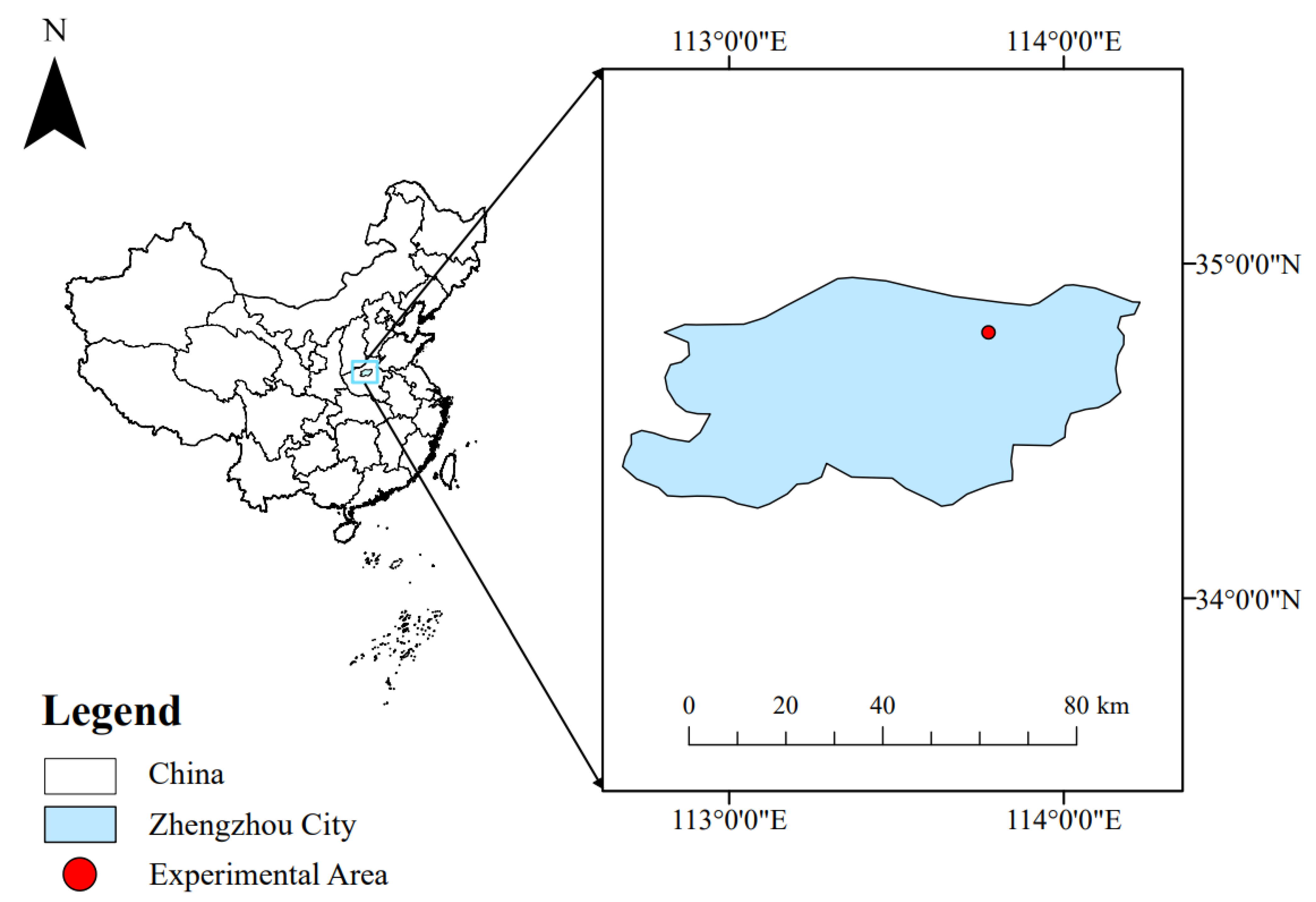

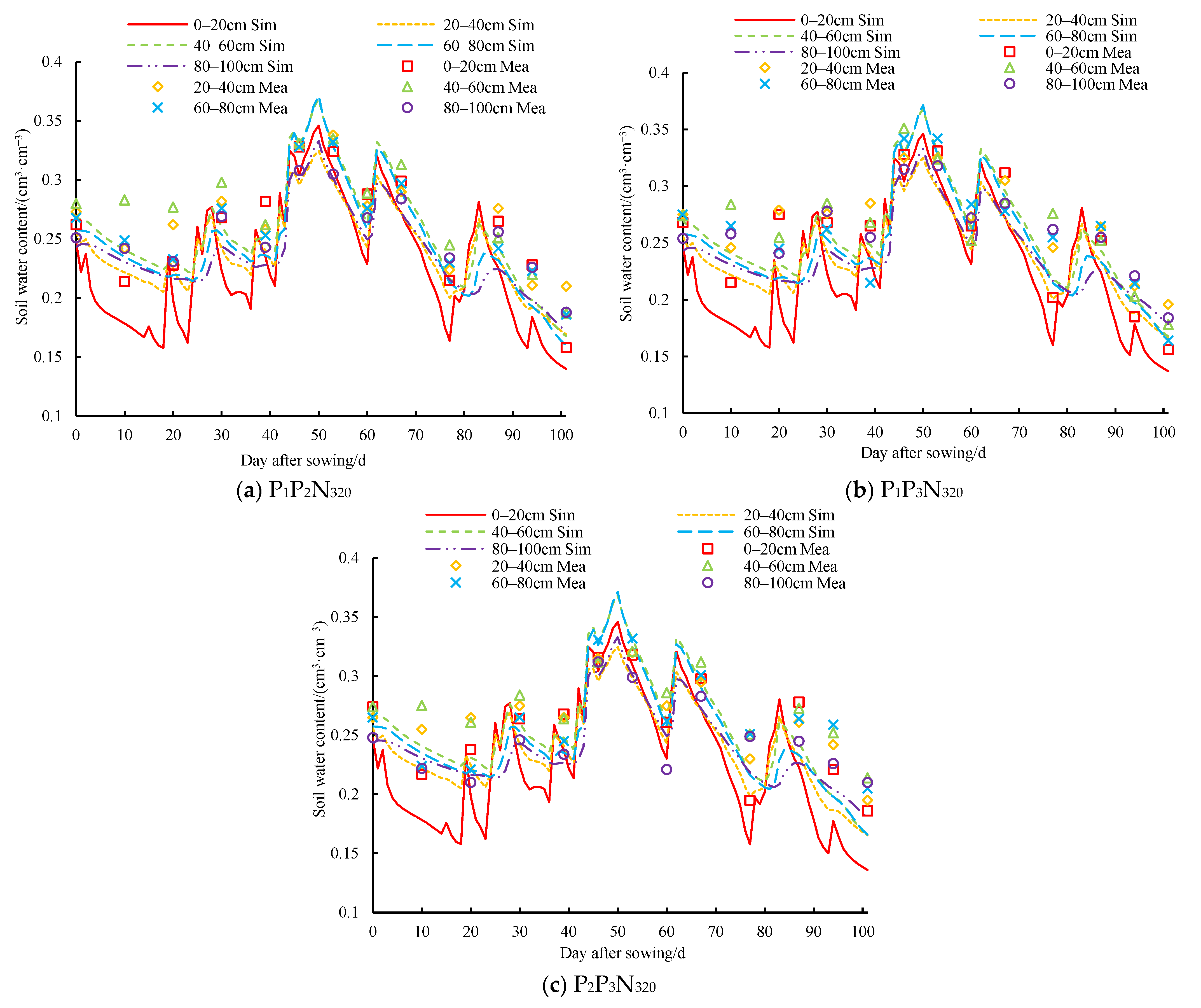
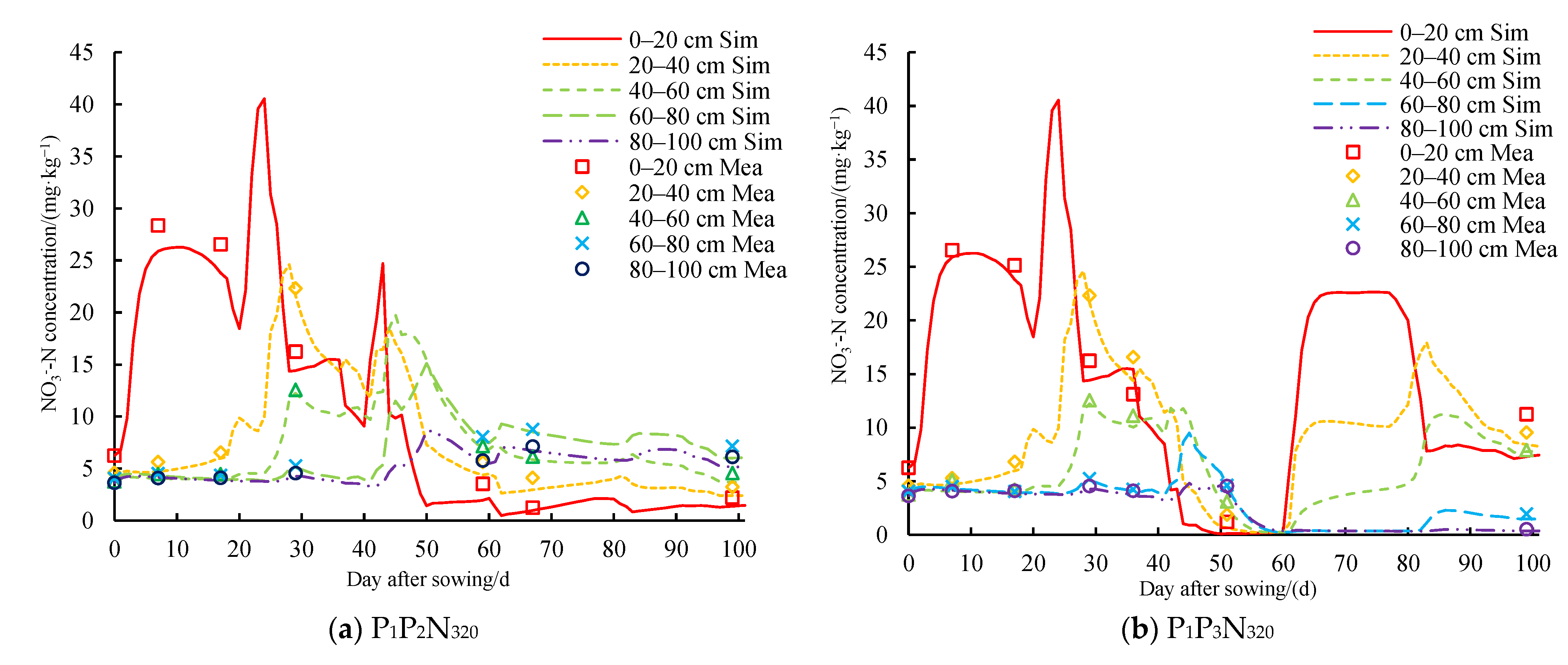
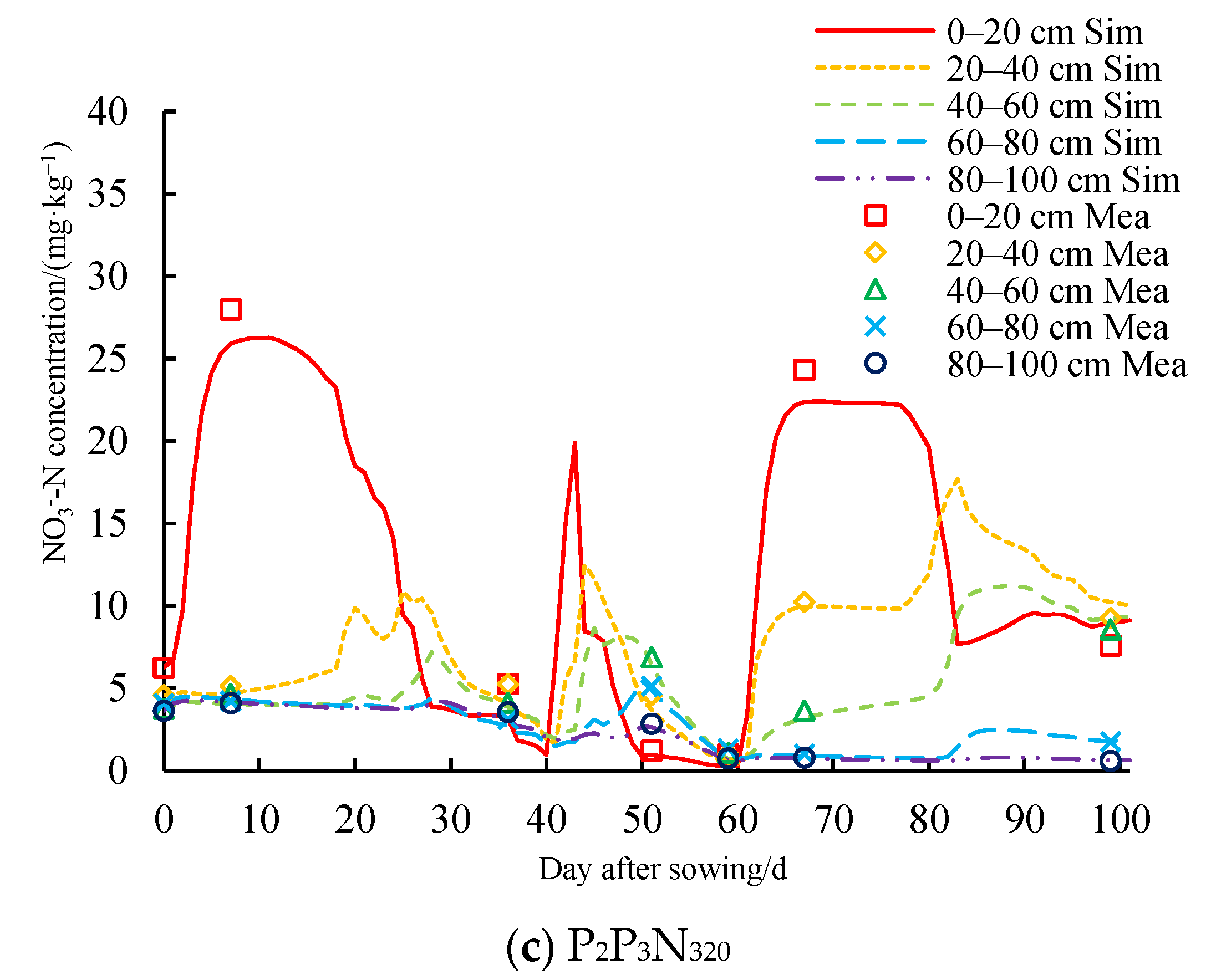
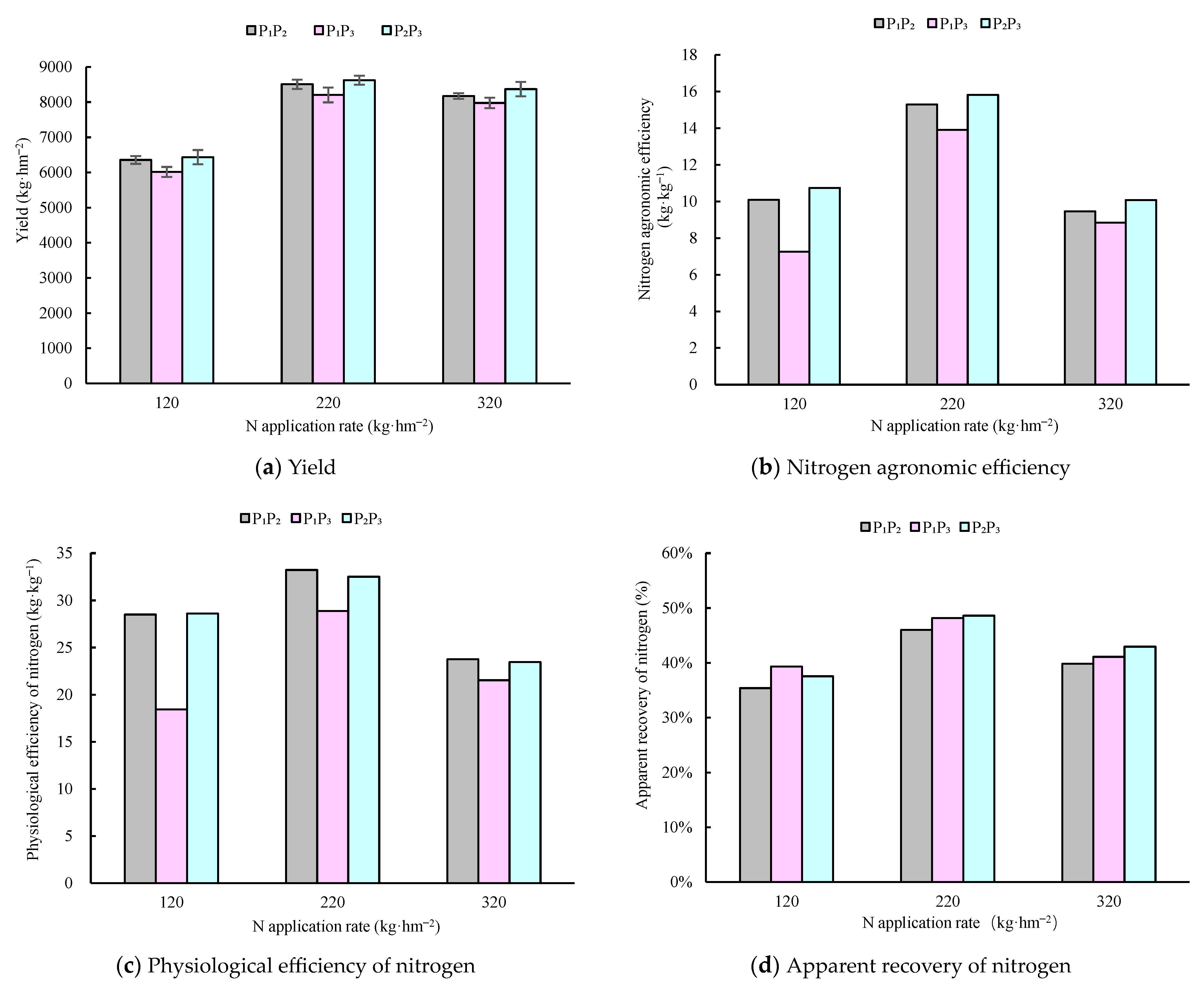
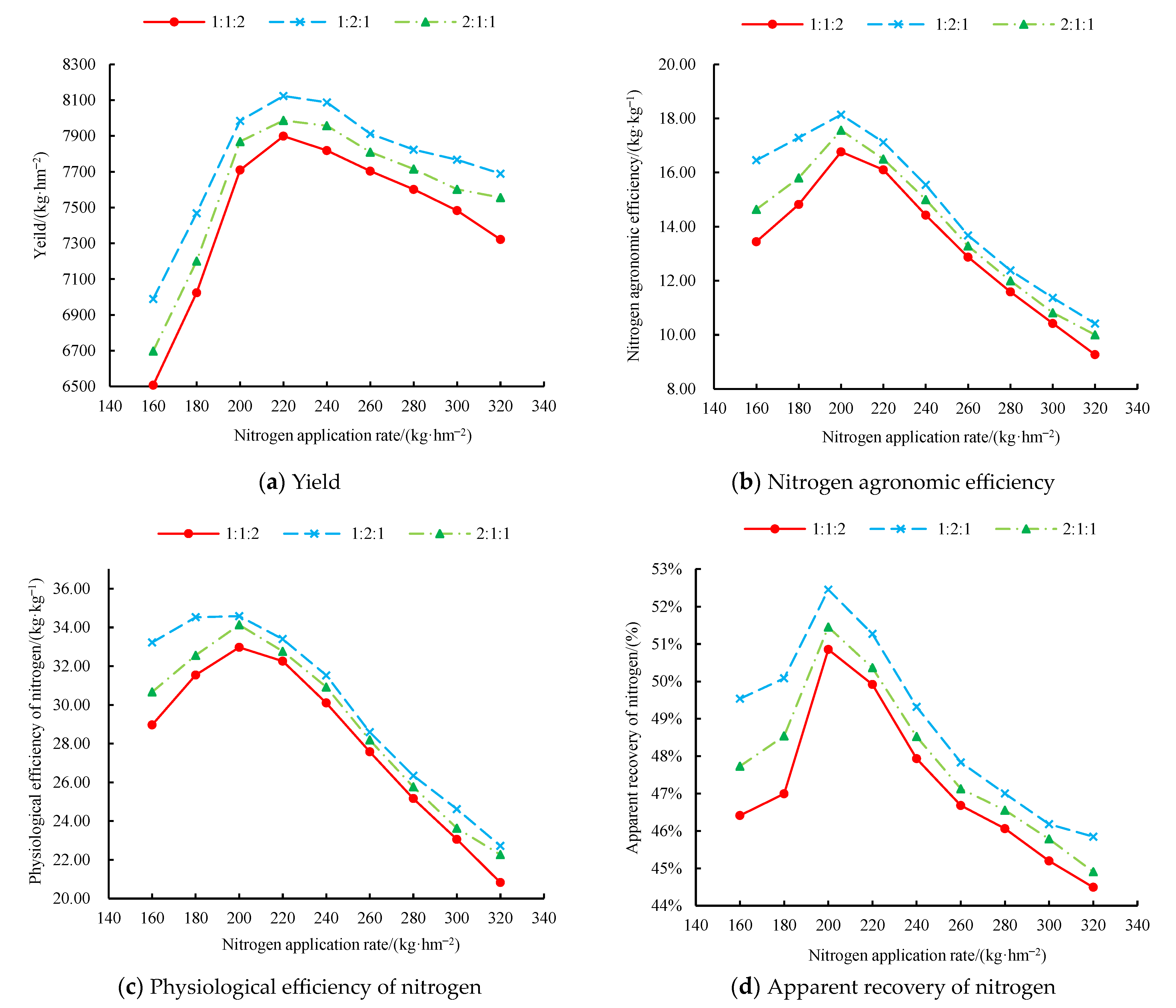
| Soil Depth (cm) | Bulk Density (g·cm−3) | Field Water Capacity (cm3·cm−3) | Permanent Wilting Point (cm3·cm−3) | Saturated Hydraulic Conductivity (cm·h−1) | Particle Gradation Composition (%) | ||
|---|---|---|---|---|---|---|---|
| <0.002 | 0.002–0.05 | >0.05–2.00 | |||||
| 0–20 | 1.48 | 0.2915 | 0.115 | 1.025 | 4.56 | 46.53 | 48.91 |
| 20–40 | 1.54 | 0.2814 | 0.136 | 0.278 | 7.38 | 44.21 | 48.41 |
| 40–60 | 1.52 | 0.3025 | 0.131 | 0.196 | 6.23 | 49.25 | 44.52 |
| 60–80 | 1.46 | 0.2924 | 0.122 | 0.523 | 4.36 | 48.25 | 47.39 |
| 80–100 | 1.48 | 0.2716 | 0.131 | 3.527 | 12.73 | 45.15 | 42.12 |
| Treatment | Base Fertilizer ** | Topdressing ** | Total ** | ||
|---|---|---|---|---|---|
| Jointing * (P1) | Trumpeting * (P2) | Anthesis * (P3) | |||
| P1P2N120 | 60 | 30 | 30 | 0 | 120 |
| P1P3N120 | 60 | 30 | 0 | 30 | 120 |
| P2P3N120 | 60 | 0 | 30 | 30 | 120 |
| P1P2N220 | 60 | 80 | 80 | 0 | 220 |
| P1P3N220 | 60 | 80 | 0 | 80 | 220 |
| P2P3N220 | 60 | 0 | 80 | 80 | 220 |
| P1P2N320 | 60 | 130 | 130 | 0 | 320 |
| P1P3N320 | 60 | 130 | 0 | 130 | 320 |
| P2P3N320 | 60 | 0 | 130 | 130 | 320 |
| CK | 0 | 0 | 0 | 0 | 0 |
| Type of Parameters | Parameter | Definition | Value Ranges | Calibration Values |
|---|---|---|---|---|
| Nitrogen conversion parameters | Anit/(s·day−1·organism−1) | Nitrification | 1.0 × 10−10–1.0 × 10−8 | 1.73 × 10−8 |
| Aden/(s·day−1·organism−1) | Denitrification | 1.0 × 10−14–1.0 × 10−12 | 4.51 × 10−13 | |
| Ahyd/(s·day−1) | Hydrolysis of Urea | 2.5 × 10−5–2.5 × 10−3 | 3.0 × 10−4 | |
| Crop parameters | P1/(°C·d−1) | Growth characteristic parameters at the seedling stage | 100–400 | 245 |
| P2/(d·h−1) | Photoperiod sensitivity | 0.01–2.00 | 0.85 | |
| P5/(°C·d−1) | Characteristic parameters during the grouting stage | 600–1000 | 800 | |
| G2 | Maximum number of grains per plant | 700–1000 | 850 | |
| G3/(mg·d−1) | Potential grouting rate | 6–12 | 9.2 | |
| PHINT/(°C·d−1) | Outlet leaf interval characteristic parameters | 30–75 | 44.5 |
| Treatment | Index | Soil Depth/cm | ||||
|---|---|---|---|---|---|---|
| 0–20 | 20–40 | 40–60 | 60–80 | 80–100 | ||
| P1P2N120 | MRE/% | 13.01% | 12.50% | 8.50% | 6.95% | 6.30% |
| RMSE/(cm3·cm−3) | 0.036 | 0.035 | 0.026 | 0.021 | 0.018 | |
| NRMSE/% | 13.73% | 12.78% | 9.46% | 8.12% | 7.08% | |
| P1P3N120 | MRE/% | 12.42% | 10.26% | 8.80% | 6.99% | 7.01% |
| RMSE/(cm3·cm−3) | 0.033 | 0.027 | 0.025 | 0.020 | 0.019 | |
| NRMSE/% | 13.16% | 10.54% | 9.27% | 7.51% | 7.65% | |
| P2P3N120 | MRE/% | 10.11% | 9.71% | 8.65% | 6.51% | 6.46% |
| RMSE/(cm3·cm−3) | 0.026 | 0.026 | 0.025 | 0.018 | 0.017 | |
| NRMSE/% | 10.58% | 10.15% | 9.09% | 6.96% | 6.72% | |
| P1P2N220 | MRE/% | 12.73% | 10.19% | 8.77% | 5.77% | 7.28% |
| RMSE/(cm3·cm−3) | 0.033 | 0.027 | 0.025 | 0.016 | 0.019 | |
| NRMSE/% | 13.05% | 10.33% | 9.17% | 6.20% | 7.57% | |
| P1P3N220 | MRE/% | 13.11% | 10.99% | 8.69% | 6.93% | 8.76% |
| RMSE/(cm3·cm−3) | 0.034 | 0.029 | 0.025 | 0.020 | 0.024 | |
| NRMSE/% | 13.51% | 11.17% | 9.11% | 7.71% | 9.34% | |
| P2P3N220 | MRE/% | 12.72% | 11.22% | 9.39% | 7.04% | 8.66% |
| RMSE/(cm3·cm−3) | 0.032 | 0.030 | 0.027 | 0.021 | 0.024 | |
| NRMSE/% | 12.81% | 11.34% | 9.78% | 8.09% | 9.35% | |
| P1P2N320 | MRE/% | 13.81% | 11.18% | 8.03% | 6.09% | 6.60% |
| RMSE/(cm3·cm−3) | 0.037 | 0.031 | 0.025 | 0.017 | 0.018 | |
| NRMSE/% | 14.42% | 11.68% | 9.19% | 6.39% | 7.07% | |
| P1P3N320 | MRE/% | 12.88% | 12.23% | 6.98% | 7.67% | 8.55% |
| RMSE/(cm3·cm−3) | 0.036 | 0.034 | 0.024 | 0.022 | 0.025 | |
| NRMSE/% | 14.26% | 12.56% | 9.10% | 8.57% | 9.42% | |
| P2P3N320 | MRE/% | 14.09% | 11.34% | 9.94% | 7.11% | 5.97% |
| RMSE/(cm3·cm−3) | 0.036 | 0.031 | 0.029 | 0.025 | 0.017 | |
| NRMSE/% | 14.09% | 11.68% | 10.65% | 9.41% | 7.00% | |
| CK | MRE/% | 13.04% | 10.68% | 9.57% | 6.81% | 7.30% |
| RMSE/(cm3·cm−3) | 0.033 | 0.030 | 0.028 | 0.019 | 0.020 | |
| NRMSE/% | 13.11% | 11.11% | 10.17% | 7.25% | 7.83% | |
| Treatment | Index | Soil Depth/cm | ||||
|---|---|---|---|---|---|---|
| 0–20 | 20–40 | 40–60 | 60–80 | 80–100 | ||
| P1P2N120 | MRE/% | 21.06% | 15.26% | 11.85% | 7.09% | 7.62% |
| RMSE/(mg·kg−1) | 1.102 | 0.482 | 0.230 | 0.199 | 0.160 | |
| NRMSE/% | 12.29% | 11.94% | 11.85% | 5.89% | 7.09% | |
| P1P3N120 | MRE/% | 17.77% | 10.88% | 4.96% | 5.03% | 4.98% |
| RMSE/(mg·kg−1) | 1.041 | 0.637 | 0.261 | 0.151 | 0.171 | |
| NRMSE/% | 10.49% | 14.42% | 8.20% | 5.84% | 7.33% | |
| P2P3N120 | MRE/% | 24.27% | 14.41% | 8.67% | 8.37% | 7.74% |
| RMSE/(mg·kg−1) | 0.911 | 0.312 | 0.206 | 0.116 | 0.160 | |
| NRMSE/% | 15.58% | 13.53% | 10.62% | 6.53% | 9.18% | |
| P1P2N220 | MRE/% | 20.54% | 15.16% | 10.34% | 6.30% | 4.36% |
| RMSE/(mg·kg−1) | 1.693 | 1.147 | 0.612 | 0.271 | 0.220 | |
| NRMSE/% | 13.34% | 14.81% | 10.38% | 5.96% | 5.66% | |
| P1P3N220 | MRE/% | 25.61% | 21.54% | 11.64% | 15.84% | 9.44% |
| RMSE/(mg·kg−1) | 1.680 | 0.934 | 0.478 | 0.250 | 0.205 | |
| NRMSE/% | 12.79% | 13.84% | 11.55% | 8.98% | 8.34% | |
| P2P3N220 | MRE/% | 20.95% | 13.57% | 7.74% | 10.70% | 6.81% |
| RMSE/(mg·kg−1) | 1.102 | 0.482 | 0.230 | 0.199 | 0.160 | |
| NRMSE/% | 13.09% | 12.59% | 8.08% | 9.87% | 8.43% | |
| P1P2N320 | MRE/% | 23.24% | 16.43% | 8.35% | 5.40% | 9.73% |
| RMSE/(mg·kg−1) | 1.995 | 1.141 | 0.636 | 0.215 | 0.313 | |
| NRMSE/% | 14.00% | 11.92% | 9.31% | 5.24% | 8.55% | |
| P1P3N320 | MRE/% | 19.18% | 14.84% | 6.94% | 5.86% | 5.48% |
| RMSE/(mg·kg−1) | 1.706 | 0.862 | 0.441 | 0.504 | 0.421 | |
| NRMSE/% | 14.15% | 11.59% | 7.16% | 8.37% | 8.32% | |
| P2P3N320 | MRE/% | 24.11% | 17.65% | 11.48% | 11.38% | 7.76% |
| RMSE/(mg·kg−1) | 1.461 | 0.737 | 0.457 | 0.290 | 0.208 | |
| NRMSE/% | 13.89% | 12.89% | 9.78% | 9.84% | 8.93% | |
| CK | MRE/% | 33.01% | 12.67% | 12.65% | 8.34% | 7.80% |
| RMSE/(mg·kg−1) | 0.510 | 0.233 | 0.136 | 0.133 | 0.111 | |
| NRMSE/% | 17.84% | 13.41% | 8.61% | 7.36% | 5.89% | |
| Treatment | Emergence (d) | Anthesis (d) | Maturity (d) | ||||||
|---|---|---|---|---|---|---|---|---|---|
| Measured | Simulated | Error | Measured | Simulated | Error | Measured | Simulated | Error | |
| P1P2N120 | 7 | 5 | −2 | 56 | 57 | 1 | 98 | 100 | 2 |
| P1P3N120 | 7 | 5 | −2 | 56 | 57 | 1 | 98 | 100 | 2 |
| P2P3N120 | 7 | 5 | −2 | 56 | 57 | 1 | 98 | 100 | 2 |
| P1P2N220 | 7 | 5 | −2 | 58 | 57 | −1 | 100 | 100 | 0 |
| P1P3N220 | 7 | 5 | −2 | 58 | 57 | −1 | 101 | 100 | −1 |
| P2P3N220 | 7 | 5 | −2 | 57 | 57 | 0 | 100 | 100 | 0 |
| P1P2N320 | 7 | 5 | −2 | 58 | 57 | −1 | 101 | 100 | −1 |
| P1P3N320 | 7 | 5 | −2 | 57 | 57 | 0 | 101 | 100 | −1 |
| P2P3N320 | 7 | 5 | −2 | 58 | 57 | −1 | 100 | 100 | 0 |
| CK | 7 | 5 | −2 | 55 | 57 | 2 | 97 | 100 | 3 |
| Treatment | Yield (kg·hm−2) | Aboveground Biomass (kg·hm−2) | Aboveground Nitrogen Uptake (kg·hm−2) | ||||||
|---|---|---|---|---|---|---|---|---|---|
| Simulated | Measured | RE | Simulated | Measured | RE | Simulated | Measured | RE | |
| P1P2N120 | 5859.56 | 6355 ± 110.62 de | −7.80% | 14,005.97 | 15,112.74 ± 243.16 c | −7.32% | 118.11 | 124.81 ± 9.33 d | −5.36% |
| P1P3N120 | 5545.56 | 6014.95 ± 141.57 e | −7.80% | 13,727.36 | 14,813.77 ± 157.37 c | −7.33% | 120.83 | 129.53 ± 13.24 d | −6.72% |
| P2P3N120 | 5923.67 | 6433.72 ± 203.74 d | −7.93% | 14,163.88 | 15,241.36 ± 203 c | −7.07% | 122.74 | 127.39 ± 6.13 d | −3.65% |
| P1P2N220 | 7987.17 | 8508.75 ± 132.73 ab | −6.13% | 16,430.72 | 18,139.29 ± 218.05 ab | −9.42% | 176.72 | 183.58 ± 12.72 c | −3.74% |
| P1P3N220 | 7789.50 | 8204.99 ± 211.13 bc | −5.06% | 16,101.62 | 17,719.27 ± 96.95 b | −9.13% | 181.39 | 188.33 ± 8.3b c | −3.68% |
| P2P3N220 | 8123.89 | 8623.67 ± 126.56 a | −5.80% | 16,872.32 | 18,311.01 ± 123.96 ab | −7.86% | 183.39 | 189.33 ± 10.02 bc | −3.14% |
| P1P2N320 | 7620.98 | 8173.75 ± 78.36 bc | −6.76% | 16,562.23 | 18,256.32 ± 216.02 ab | −9.28% | 201.97 | 209.84 ± 11.16 ab | −3.75% |
| P1P3N320 | 7545.50 | 7975.9 ± 147.79 c | −5.40% | 16,352.56 | 17,992.32 ± 135.89 ab | −9.11% | 203.78 | 213.87 ± 12.26 ab | −4.72% |
| P2P3N320 | 7789.60 | 8369.32 ± 203.53 abc | −6.93% | 17,025.56 | 18,411.74 ± 206.8 a | −7.53% | 205.69 | 219.81 ± 8.76 a | −6.42% |
| CK | 4356.56 | 5144.76 ± 194.92 f | −15.32% | 10,234.26 | 12,066.73 ± 636.59 d | −15.19% | 71.52 | 82.34 ± 9.35 e | −13.14% |
| RMSE | 535.59 | 1483.58 | 8.68 | ||||||
| NRMSE | 7.26% | 8.93% | 5.20% | ||||||
| MRE | 7.49% | 8.92% | 5.43% | ||||||
| Treatment | Nitrogen Agronomic Efficiency (kg/kg) | Physiological Efficiency of Nitrogen (kg/kg) | Apparent Recovery of Nitrogen (%) | ||||||
|---|---|---|---|---|---|---|---|---|---|
| Measured | Simulated | RE | Measured | Simulated | RE | Measured | Simulated | RE | |
| P1P2N120 | 10.09 | 12.53 | 24.13% | 28.5 | 32.26 | 13.18% | 35.39 | 40.93 | 9.72% |
| P1P3N120 | 7.25 | 9.91 | 36.67% | 18.4 | 24.12 | 30.78% | 39.32 | 43.19 | 4.47% |
| P2P3N120 | 10.74 | 13.06 | 21.59% | 28.61 | 30.60 | 6.95% | 37.54 | 44.78 | 13.69% |
| P1P2N220 | 15.29 | 16.50 | 7.93% | 33.23 | 34.51 | 3.86% | 46.02 | 48.96 | 3.90% |
| P1P3N220 | 13.91 | 15.60 | 12.18% | 28.87 | 31.25 | 8.23% | 48.18 | 51.09 | 3.66% |
| P2P3N220 | 15.81 | 17.12 | 8.31% | 32.52 | 33.68 | 3.55% | 48.63 | 52.00 | 4.57% |
| P1P2N320 | 9.47 | 10.20 | 7.72% | 23.76 | 25.02 | 5.32% | 39.84 | 41.55 | 2.33% |
| P1P3N320 | 8.85 | 9.97 | 12.60% | 21.52 | 24.11 | 12.04% | 41.10 | 42.12 | 0.56% |
| P2P3N320 | 10.08 | 10.73 | 6.43% | 23.46 | 25.59 | 9.07% | 42.96 | 42.72 | −2.40% |
| CK | - | - | - | - | - | - | - | - | - |
| MRE | 15.29% | 10.33% | 4.50% | ||||||
| RMSE | 1.720 | 2.820 | 0.020 | ||||||
| NRMSE | 15.25% | 10.62% | 4.75% | ||||||
| Scenario | Positive Ideal Solution Distance (D+) | Negative Ideal Solution Distance (D−) | Relative Proximity (C) | Sorting Result |
|---|---|---|---|---|
| P1P2N120 | 0.225 | 0.149 | 0.398 | 6 |
| P1P2N220 | 0.026 | 0.324 | 0.926 | 2 |
| P1P2N320 | 0.228 | 0.135 | 0.373 | 7 |
| P1P3N120 | 0.334 | 0.031 | 0.085 | 9 |
| P1P3N220 | 0.079 | 0.269 | 0.773 | 3 |
| P1P3N320 | 0.255 | 0.113 | 0.307 | 8 |
| P2P3N120 | 0.203 | 0.163 | 0.445 | 4 |
| P2P3N220 | 0.009 | 0.338 | 0.975 | 1 |
| P2P3N320 | 0.209 | 0.156 | 0.428 | 5 |
| Treatment | Base Fertilizer | Topdressing | Fertilizer Application Rate | Total | |
|---|---|---|---|---|---|
| Trumpeting | Anthesis | ||||
| N160 (1:1:2) | 40 | 40 | 80 | 1:1:2 | 160 |
| N160 (1:2:1) | 40 | 80 | 40 | 1:2:1 | 160 |
| N160 (2:1:1) | 80 | 40 | 40 | 2:1:1 | 160 |
| N180 (1:1:2) | 45 | 45 | 90 | 1:1:2 | 180 |
| N180 (1:2:1) | 45 | 90 | 45 | 1:2:1 | 180 |
| N180 (2:1:1) | 90 | 45 | 45 | 2:1:1 | 180 |
| N200 (1:1:2) | 50 | 50 | 100 | 1:1:2 | 200 |
| N200 (1:2:1) | 50 | 100 | 50 | 1:2:1 | 200 |
| N200 (2:1:1) | 100 | 50 | 50 | 2:1:1 | 200 |
| N220 (1:1:2) | 55 | 55 | 110 | 1:1:2 | 220 |
| N220 (1:2:1) | 55 | 110 | 55 | 1:2:1 | 220 |
| N220 (2:1:1) | 110 | 55 | 55 | 2:1:1 | 220 |
| N240 (1:1:2) | 60 | 60 | 120 | 1:1:2 | 240 |
| N240 (1:2:1) | 60 | 120 | 60 | 1:2:1 | 240 |
| N240 (2:1:1) | 120 | 60 | 60 | 2:1:1 | 240 |
| N260 (1:1:2) | 65 | 65 | 130 | 1:1:2 | 260 |
| N260 (1:2:1) | 65 | 130 | 65 | 1:2:1 | 260 |
| N260 (2:1:1) | 130 | 65 | 65 | 2:1:1 | 260 |
| N280 (1:1:2) | 70 | 70 | 140 | 1:1:2 | 280 |
| N280 (1:2:1) | 70 | 140 | 70 | 1:2:1 | 280 |
| N280 (2:1:1) | 140 | 70 | 70 | 2:1:1 | 280 |
| N300 (1:1:2) | 75 | 75 | 150 | 1:1:2 | 300 |
| N300 (1:2:1) | 75 | 150 | 75 | 1:2:1 | 300 |
| N300 (2:1:1) | 150 | 75 | 75 | 2:1:1 | 300 |
| N320 (1:1:2) | 80 | 80 | 160 | 1:1:2 | 320 |
| N320 (1:2:1) | 80 | 160 | 80 | 1:2:1 | 320 |
| N320 (2:1:1) | 160 | 80 | 80 | 2:1:1 | 320 |
| Scenario | Positive Ideal Solution Distance (D+) | Negative Ideal Solution Distance (D−) | Relative Proximity (C) | Sorting Result |
|---|---|---|---|---|
| N160 (1:1:2) | 0.084 | 0.082 | 0.494 | 17 |
| N160 (1:2:1) | 0.038 | 0.131 | 0.776 | 8 |
| N160 (2:1:1) | 0.065 | 0.101 | 0.610 | 14 |
| N180 (1:1:2) | 0.059 | 0.106 | 0.643 | 12 |
| N180 (1:2:1) | 0.022 | 0.145 | 0.869 | 4 |
| N180 (2:1:1) | 0.043 | 0.120 | 0.737 | 9 |
| N200 (1:1:2) | 0.024 | 0.134 | 0.847 | 5 |
| N200 (1:2:1) | 0.004 | 0.157 | 0.978 | 1 |
| N200 (2:1:1) | 0.011 | 0.148 | 0.929 | 2 |
| N220 (1:1:2) | 0.034 | 0.125 | 0.788 | 7 |
| N220 (1:2:1) | 0.017 | 0.142 | 0.892 | 3 |
| N220 (2:1:1) | 0.027 | 0.132 | 0.83 | 6 |
| N240 (1:1:2) | 0.061 | 0.098 | 0.616 | 13 |
| N240 (1:2:1) | 0.043 | 0.117 | 0.733 | 10 |
| N240 (2:1:1) | 0.052 | 0.108 | 0.678 | 11 |
| N260 (1:1:2) | 0.088 | 0.072 | 0.451 | 18 |
| N260 (1:2:1) | 0.075 | 0.086 | 0.536 | 15 |
| N260 (2:1:1) | 0.081 | 0.080 | 0.496 | 16 |
| N280 (1:1:2) | 0.111 | 0.051 | 0.313 | 21 |
| N280 (1:2:1) | 0.097 | 0.065 | 0.399 | 19 |
| N280 (2:1:1) | 0.104 | 0.058 | 0.357 | 20 |
| N300 (1:1:2) | 0.132 | 0.033 | 0.198 | 25 |
| N300 (1:2:1) | 0.115 | 0.049 | 0.299 | 22 |
| N300 (2:1:1) | 0.125 | 0.039 | 0.239 | 23 |
| N320 (1:1:2) | 0.154 | 0.021 | 0.118 | 27 |
| N320 (1:2:1) | 0.133 | 0.036 | 0.213 | 24 |
| N320 (2:1:1) | 0.140 | 0.030 | 0.175 | 26 |
Disclaimer/Publisher’s Note: The statements, opinions and data contained in all publications are solely those of the individual author(s) and contributor(s) and not of MDPI and/or the editor(s). MDPI and/or the editor(s) disclaim responsibility for any injury to people or property resulting from any ideas, methods, instructions or products referred to in the content. |
© 2023 by the authors. Licensee MDPI, Basel, Switzerland. This article is an open access article distributed under the terms and conditions of the Creative Commons Attribution (CC BY) license (https://creativecommons.org/licenses/by/4.0/).
Share and Cite
Wang, S.; Luo, M.; Liu, T.; Li, Y.; Ding, J.; Yang, R.; Liu, Y.; Zhou, W.; Wang, D.; Zhang, H. Optimization of Nitrogen Fertilizer Management in the Yellow River Irrigation Area Based on the Root Zone Water Quality Model. Agronomy 2023, 13, 1628. https://doi.org/10.3390/agronomy13061628
Wang S, Luo M, Liu T, Li Y, Ding J, Yang R, Liu Y, Zhou W, Wang D, Zhang H. Optimization of Nitrogen Fertilizer Management in the Yellow River Irrigation Area Based on the Root Zone Water Quality Model. Agronomy. 2023; 13(6):1628. https://doi.org/10.3390/agronomy13061628
Chicago/Turabian StyleWang, Shunsheng, Minpeng Luo, Tengfei Liu, Yuan Li, Jiale Ding, Ruijie Yang, Yulong Liu, Wang Zhou, Diru Wang, and Hao Zhang. 2023. "Optimization of Nitrogen Fertilizer Management in the Yellow River Irrigation Area Based on the Root Zone Water Quality Model" Agronomy 13, no. 6: 1628. https://doi.org/10.3390/agronomy13061628
APA StyleWang, S., Luo, M., Liu, T., Li, Y., Ding, J., Yang, R., Liu, Y., Zhou, W., Wang, D., & Zhang, H. (2023). Optimization of Nitrogen Fertilizer Management in the Yellow River Irrigation Area Based on the Root Zone Water Quality Model. Agronomy, 13(6), 1628. https://doi.org/10.3390/agronomy13061628





